Lincoln Motor Company
 | |
| Division | |
| Industry | Automotive |
| Founded |
August 1917 (as Lincoln Motor Company) Dearborn, Michigan, U.S.[1]:4 |
| Founders |
|
| Headquarters | Dearborn, Michigan, U.S. |
Area served |
|
Key people | Joy Falotico (Group Vice President, Lincoln Motor Company since March 1, 2018)[3] |
| Products | Luxury cars |
| Parent |
Ford Motor Company (February 4, 1922[4]–present) |
| Website |
www |
Lincoln, formally the Lincoln Motor Company, is a luxury vehicle brand of the American manufacturer Ford Motor Company. Throughout its existence, Lincoln has been marketed among the top luxury brands in the United States, having a segment rivalry against Cadillac for nearly a century. The brand was named after 16th US President Abraham Lincoln by company founder Henry M. Leland. Lincoln has the distinction of establishing the personal luxury car segment, with the entry of the Lincoln Continental into mass production in 1940.
Founded in 1917, Lincoln Motor Company was purchased by Ford Motor Company in 1922.[5] Following World War II, Lincoln was paired with the mid-range Mercury brand, forming the Lincoln-Mercury division. In 2012, Ford rebranded the Lincoln division under its original name, Lincoln Motor Company.[6] Originally founded as a freestanding division above Lincoln, Continental was integrated into Lincoln in 1959. The Continental-branded Mark Series was marketed through Lincoln starting in 1968, adapting the Lincoln name in 1986. The Lincoln star emblem is derived from a badge first used on the 1956 Continental Mark II.
Following the divestiture of Jaguar, Land Rover, Aston Martin and Volvo, Lincoln became and remains the sole luxury nameplate of Ford Motor Company. The current product range of Lincoln consists of sedans, crossovers, and SUVs. Outside of retail markets, Lincoln has produced vehicles for limousine and livery use throughout its entire existence, with several examples used as official state limousines for Presidents of the United States.
In 2017, Lincoln sold 188,383 vehicles globally.[7] Outside of North America, Lincoln vehicles are officially sold in the Middle East, China, and South Korea.
History
Early years (1917-1930)
The Lincoln Motor Company was founded in August 1917 by Henry Leland and his son Wilfred. Among the founders of Cadillac, Leland had sold the company to General Motors in 1909, remaining on as an executive until 1917, when he left over a dispute with GM President William Durant. Naming Lincoln Motor Company after Abraham Lincoln, the first President for whom he ever voted (1864), Leland financed the company by securing a $10 million contract to build Liberty V12 aircraft engines, breaking ground on the Lincoln Motor Company Plant. To build the Liberty engines, Lincoln sourced parts from other manufacturers; along with cylinders produced by Ford, other parts were sourced from Buick, Cadillac, Marmon, and Packard.[8]:4[9]:163–164 In total, 6,500 Liberty V12 engines were produced by Lincoln before the end of World War I ceased wartime production.
Following a complete retooling for automobile production, Lincoln Motor Company developed its first automobile, the Lincoln Model L. Intended as a rival for Cadillac and similar luxury car manufacturers, the Model L was powered by a V8 engine, derived from the technology of the Liberty V12.
Purchase by Ford Motor Company
During the early 1920s, Lincoln Motor Company struggled with the shift from military to automobile production, with some customers having to wait nearly a year for their vehicles to be completed from the time of purchase.[10] By 1922, Lincoln fell on the verge of bankruptcy and was placed in receivership. On February 4, 1922, Lincoln Motor Company was acquired by Ford Motor Company for $8 million.[11] Although Henry Ford had previously designed several luxury vehicles under the Ford brand (the 1904 Ford Model B, the 1905 Ford Model F, and the 1906 Ford Model K), Ford sought to create a stand-alone luxury-vehicle division[12], as General Motors had done with Cadillac. With the acquisition of Lincoln, Ford Motor Company produced a rival for Cadillac, Pierce-Arrow, Marmon, Peerless, Duesenberg, and Packard alongside the Ford Model T.
In addition to more closely competing against General Motors in different price segments, the purchase of Lincoln also held personal value within Ford management. In 1902, Henry Ford had been forced out of his second company (Henry Ford Company) by a group of investors led by Leland.[13]:52–57 Henry Ford Company was renamed Cadillac Automobile Company; sold to General Motors in 1909, Cadillac has remained a chief competitor of Lincoln from 1920 to the present day. While Henry and Wilfred Leland were initially retained to manage Lincoln, on June 10, 1922, both Lelands were removed, with Edsel Ford brought in to manage the company.
Following the introduction of Edsel Ford to Lincoln management, the fortunes of Lincoln began to quickly improve. For 1923, the Lincoln Model L underwent extensive changes. While the chassis and drivetrain (including an L-head 60-degree V8) were largely left alone, several new bodystyles were introduced. In line with a Duesenberg or a Rolls-Royce, customers could also purchase a Model L with coachbuilt bodywork. For 1923, Lincoln produced 7,875 cars (nearly 45% higher than 1922), operating at a profit by the end of the year.
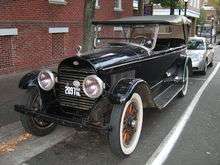 1922 Lincoln Model L touring sedan
1922 Lincoln Model L touring sedan 1925 Lincoln Model L sedan (of Greta Garbo)
1925 Lincoln Model L sedan (of Greta Garbo)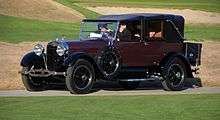 1926 Lincoln Model L town car
1926 Lincoln Model L town car.jpg) 1930 Lincoln Model L sedan
1930 Lincoln Model L sedan
1930s
During the early 1920s, Lincoln steered away from the common American automotive industry practice of yearly model changes. While used to market fresh designs to customers, Lincoln found that its customers had begun to purchase multiple Lincolns (or other luxury vehicles) in different bodystyles; yearly styling changes would not properly accommodate its customer base. Following the 1930 model year, however, Lincoln chose to withdraw the Model L in favor of a more modern vehicle. For 1931, the Lincoln Model K was introduced as a competitor to the Cadillac 355 Chrysler Imperial, Duesenberg Model J, and Packard Eight.
For 1932, Lincoln became an American manufacturer to produce a "multi-cylinder" engine as it introduced its first V12 engine. While not the first to produce a V12 engine in an American-produced car, in 1933, Lincoln became the first manufacturer to produce vehicles exclusively with V12 engines, as it retired the L-head V8 engine.
During the 1930s, Lincoln expanded to two model lines for the first time. As Lincoln shifted the Model K upwards in price, Edsel Ford introduced the Lincoln-Zephyr as a sub-marque within Lincoln for 1936.[14]:155 Designed to compete against the LaSalle and Chrysler Airstream, the Lincoln-Zephyr introduced an all-new body and chassis, along with its own V12 engine. As a result, Lincoln sales increased ninefold from 1935 to 1936.[15]:1196–1197
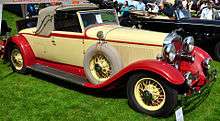 1931 Lincoln Model K
1931 Lincoln Model K- 1932 Lincoln Model KA (V8) six-window sedan
.jpg) 1935 Lincoln Model K
1935 Lincoln Model K 1938 Lincoln-Zephyr 4-door sedan
1938 Lincoln-Zephyr 4-door sedan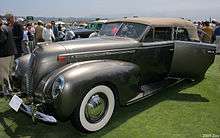 1938 Lincoln Model K Convertible Sedan (body by LeBaron)
1938 Lincoln Model K Convertible Sedan (body by LeBaron)
Beginning of Lincoln Continental
In the late 1930s, Edsel Ford began to consider American cars too boxy. In late 1938, to develop a European-style car for his next Florida vacation, he commissioned Ford Chief Stylist E. T. Gregorie to design a one-off body design, using a 1939 Lincoln-Zephyr Convertible Coupe chassis. After sectioning the body 4 inches (102 mm), the running boards were deleted and a spare tire was mounted behind the trunklid.
After Edsel Ford received the car and vacationed in Florida with the one-off vehicle, it attracted a high amount of interest from potential buyers, often referring to its "European" or "Continental" exterior design. From the latter term, the one-off vehicle became known as the Lincoln Continental.
1940s
Following the Great Depression, a number of American luxury car manufacturers were either forced into closure or reorganization; by 1940, alongside Lincoln, the American luxury-car segment largely consisted of Cadillac (who ended production of the LaSalle and V16 in 1940), the Chrysler Imperial (reduced to 8-passenger sedans and limousines), and Packard. To further secure the future for Lincoln, on April 30, 1940, Ford Motor Company reorganized Lincoln Motor Company as the Lincoln Division of Ford Motor Motor Company.[16]:199 While previously operating as an autonomous entity, as a division, Lincoln structurally became similar to its major competitor Cadillac (within General Motors).
As part of the change, several changes were made to the Lincoln model line. Following the positive feedback of the 1939 Lincoln Continental one-off convertible built for Edsel Ford, the Lincoln Continental was introduced as a Lincoln-Zephyr production model for 1940. For 1941, Lincoln revised its branding; the hyphen was removed from Lincoln-Zephyr, making it a Lincoln.[16]:206 As a replacement for the expensive Model K, an extended-wheelbase Lincoln Custom variant of the Lincoln Zephyr was developed. Following the development of proper tooling, the Lincoln Continental began production on the assembly line, replacing hand-built construction.
After the entry of the United States into World War II, as with all U.S. auto manufacturers, Lincoln ended automobile production as Ford Motor Company concentrated on wartime manufacturing. Following the conclusion of the war in 1945, the structure of Lincoln within Ford changed again, as the Lincoln-Mercury Division was created, pairing Mercury and Lincoln together; from 1945 to the 2010 closure of Mercury, the two luxury divisions were paired together within Ford.
For 1946, Lincoln returned to production, ending the use of the Zephyr name. Code-named the H-series, non-Continental Lincolns were identified by their body style. Using slightly updated exteriors from 1942, the 1946 Lincolns continued the use of the Zephyr chassis. 1948 marked the final year of the Zephyr chassis (dating to 1936) and (as of 2018) the use of a V12 engine in an American mass-produced automobile. After 5,322 were produced (as both a Lincoln-Zephyr and Lincoln), Lincoln ended production of the Continental.
For 1949, all three Ford Motor Company divisions debuted their first postwar designs. Sharing its body structure with the Mercury Eight, the redesigned Lincoln model line (code-named the EL-series) marked the first use of a V8 in a Lincoln since 1932. An all-new V12 intended for Lincoln was stillborn in development, leading the division to adapt a Ford flathead V8 (from the Ford F-8 conventional truck). As with the previous Lincoln Continental, the 1949 Lincoln dispensed with running boards completely, moving on to abandon pontoon styling entirely, with a straight fender line (and low hoodline) from headlamp to taillamp. In a carryover from Zephyr-based Lincolns, the 1949 Lincolns retained rear-hinged passenger doors. As a flagship model of Lincoln, the Lincoln Cosmopolitan was styled with its own rear roofline.
.jpg) 1940 Lincoln Zephyr
1940 Lincoln Zephyr.jpg) 1942 Lincoln Continental coupe
1942 Lincoln Continental coupe.jpg) 1946 Lincoln (coupe)
1946 Lincoln (coupe)- 1948 Lincoln (sedan)
 1948 Lincoln Continental
1948 Lincoln Continental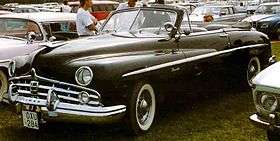 1949 Lincoln (convertible)
1949 Lincoln (convertible)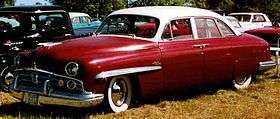 1949 Lincoln Cosmopolitan
1949 Lincoln Cosmopolitan
1950s
As Lincoln entered the 1950s, Ford Motor Company sought to increase the differentiation between the Mercury and Lincoln model lines. For 1952, to add interest to the brand, Lincoln returned to model names for the first time since 1942, with the Lincoln Cosmopolitan becoming the standard Lincoln model, with the Lincoln Capri becoming the flagship model line. In a return to (small) pontoon rear fenders, Lincolns shared a body with the Mercury Monterey. Mechanically, Lincoln differed from Mercury, as the Ford truck V8 was replaced by the Lincoln Y-block V8 with a Hydramatic transmission. For the first time since the discontinuation of the Model K, Lincolns were produced with front-hinged rear doors.
For 1956, the shared Lincoln-Mercury body underwent a redesign for the final time, with Lincoln adopting elements from the Mercury XM-800 and Lincoln Futura concept cars. Slotted above the Lincoln Capri, the Lincoln Premiere adapted features of the Continental Mark II, including its ducted air conditioning.
During 1956, Lincoln-Mercury was reorganized slightly, following the creation of the free-standing Edsel and Continental divisions, Lincoln-Mercury was changed to Mercury-Edsel-Lincoln (MEL), with Edsel slotted alongside/below Mercury and Continental above Lincoln, as the flagship of all of Ford Motor Company. By the end of 1959, Continental was integrated into Lincoln and Edsel was withdrawn.
The Lincoln Motor Company Plant, built in Detroit, Michigan by Henry Leland in 1917, was closed after 1952; subsequent Lincolns were produced alongside Mercury Montereys and Mercury Montclairs. For the 1957 model year, Ford opened Wixom Assembly in Wixom, Michigan as a facility to specialize in Lincoln production. From 1957 to 2007, the facility produced Lincoln vehicles nearly exclusively, along with the Ford GT and several generations of the Ford Thunderbird.
 1950 Lincoln (sedan)
1950 Lincoln (sedan)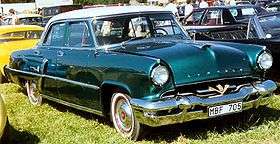 1953 Lincoln Capri
1953 Lincoln Capri.jpg) 1955 Lincoln Capri
1955 Lincoln Capri 1956 Lincoln Premiere
1956 Lincoln Premiere.jpg) 1957 Lincoln Premiere Landau (4-door hardtop)
1957 Lincoln Premiere Landau (4-door hardtop)- 1959 Lincoln Premiere
Continental Division (1956–1959)
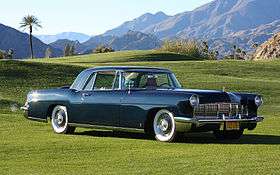
For the 1956 model year, Ford Motor Company created the Continental Division, slotted above Lincoln as the flagship marque of Ford Motor Company. At its launch, Continental introduced the Continental Mark II as its model line, intended as a successor to the 1940-1948 Lincoln Continental personal luxury car. Offered as a two-door hardtop coupe, the Mark II broke from a number of American styling precedents of the time. While fitted with whitewall tires, the exterior was fitted with minimal chrome trim on the body sides; tailfins were left off of the body completely. In place of the bumper-mounted spare tire of the original Lincoln Continental, the trunklid of the Mark II showcased the design element, with a large imitation spare tire bulge (which fit over the actual spare tire inside the trunk). The Mark II was largely hand-built, with extensive quality testing done to each engine and transmission before leaving the factory.
In place of establishing a separate sales and service network for Continental, the Mark II was marketed through Lincoln (the Mark II used a Lincoln engine and transmission). At $10,000 in 1956 (equivalent to $90,012 in 2017[17]), the Mark II was the most expensive car produced by an American automaker at the time, rivaling the Rolls-Royce Silver Cloud in price.
On July 18, 1956, the Continental Division was integrated into Lincoln which continued to manage the Continental brand as a separate marque.[18]:281 During the 1957 model year, the Mark II was withdrawn, largely as a consequence of its hand-built construction; each unit was sold at a loss of over $1,000. Subsequently, the 1957 Cadillac Eldorado Brougham overtook the Mark II as the most expensive American-produced vehicle.
For 1958, as part of a mandated $4000 reduction in price, Continental adopted the body of Lincoln, expanding into multiple body styles for the Mark III (the nomenclature indicating the transition). Adding a feature of the Mercury Turnpike Cruiser, Continental adopted a retractable rear window across every bodystyle (including convertibles) with a reverse-slant rear roofline. For 1959, the Mark III was renamed the Mark IV, becoming the Mark V for 1960.[18]:331,337,414, 582–583
In 1959, the Continental Division was formally brought to an end within Lincoln; for 1960, the Mark V was brought to production, ending the model cycle alongside the standard Lincoln model line.
Unibody vehicles
For the 1958 model year, the Mercury-Edsel-Lincoln (M-E-L) division adapted new bodies across its vehicle lines. In addition to Mercury sharing its bodies with the premium Edsels (prior to the latter's demise), Lincoln and Continental adopted a common body structure, shifting to unibody construction. With a 131-inch wheelbase, the new platform would be among the largest vehicles ever built by Ford Motor Company; they are the longest Lincolns ever built without 5-mph bumpers.
As a replacement for the Y-block V8, Ford developed a 430 cubic-inch "MEL" V8 as standard equipment for Lincolns (also in Ford Thunderbirds and some Mercury vehicles).
For 1959, Continental developed Town Car and Limousine variants of the standard four-door sedan. In place of extending the wheelbase, the reverse-slant roofline was replaced by a formal notchback configuration, allowing the rear seat to be moved rearward several inches. Among the rarest Lincoln vehicles ever produced, the Town Car and Limousines were only offered painted in black.
1960s
From 1958 to 1960, Lincoln would lose over $60 million dollars. Following the recession economy of the late 1950s (a factor that would play into the demise of Edsel), Ford Motor Company was forced to recoup the development costs of a vehicle platform that Lincoln shared with neither Ford nor Mercury (with the lone exception of the engine and transmission). By 1958, the future of Lincoln-Mercury was at risk, with Ford President Robert McNamara considering the reduction of Ford to its namesake brand.[19] As a condition of allowing Lincoln to continue production, McNamara required the Lincoln model line to undergo a reduction in size.[19]
For 1961, Lincoln consolidated its model lineup to a single model line, with the Lincoln Continental replacing the Lincoln Capri and Lincoln Premiere; as the Continental marque was withdrawn, the Mark V saw no successor. While only nominally lighter than the 1960 Lincoln, the 1961 Lincoln Continental adapted a far smaller exterior footprint, shedding 15 inches in length and 8 inches of wheelbase. In an effort to streamline production, only four-door body styles were produced, with the Continental becoming the sole mass-produced four-door convertible sold in North America; to maximize rear-seat egress, Lincoln returned to the use of rear suicide doors.
In another requirement to ensure its survival, the model cycle of Lincoln was extended from three years to nine years.[20] While largely dispensing with major yearly model changes, the decision established design consistency and shifting resources towards quality control.[21] For 1966, to better compete with the Cadillac Coupe de Ville and the Imperial Crown/LeBaron Coupe, Lincoln added a two-door hardtop to the Continental model line. After the 1967 model year, Lincoln ended production of the Continental 4-door convertible. At 5,712 pounds[22], the 1967 Lincoln Continental Convertible is the heaviest non-limousine car ever produced by Ford Motor Company; as of 2018, it is the final factory-produced four-door convertible sold in North America.
.jpg) 1960 Lincoln Continental Mark V hardtop sedan
1960 Lincoln Continental Mark V hardtop sedan.jpg) 1961 Lincoln Continental sedan
1961 Lincoln Continental sedan.jpg) 1963 Lincoln Continental convertible
1963 Lincoln Continental convertible.jpg) 1964 Lincoln Continental convertible (top raised)
1964 Lincoln Continental convertible (top raised).jpg) 1967 Lincoln Continental coupe
1967 Lincoln Continental coupe.jpg) 1969 Lincoln Continental sedan
1969 Lincoln Continental sedan
Continental Mark III
During the 1960s, Ford sought to develop a new flagship vehicle as a successor for the Continental Mark II. While the Lincoln Continental served as a close competitor to the Cadillac de Ville series and Chrysler Imperial, as Cadillac shifted the Cadillac Eldorado to the personal luxury segment in 1967, a segment that Ford exited in 1957 after the withdrawal of the Continental Mark II. As a response, in April 1968, the Continental Mark III was released as a 1969 model. While not officially a Lincoln, the Continental Mark III was marketed through the Lincoln-Mercury dealer network, who would service the vehicle. Over a number of various names considered for the vehicle, Continental Mark III was chosen, as Henry Ford II felt the Continental Mark II did not have a proper successor (thus restarting the nomenclature).[23]
Alongside the 1968 Lincoln Continental, the Continental Mark III marked the debut of the (then-new) 460 cubic-inch V8 and became the first Ford vehicle to be fitted with anti-lock brakes.[24] As standard equipment, the Mark III was fitted with power door locks, power seats, and power windows. In an effort to control its development and production costs, the Mark III was offered only as a two-door hardtop derived from the chassis underpinnings of the four door Ford Thunderbird. While sharing many styling elements from Lincoln, the Continental Mark III debuted many elements of its own, including hidden headlights and a redesigned spare-tire trunklid (the spare tire laid flat in the front of the trunk).
.jpg) 1969 Continental Mark III
1969 Continental Mark III.jpg) Rear view showing trunklid, 1969 Continental Mark III
Rear view showing trunklid, 1969 Continental Mark III.jpg) Interior view, 1970 Continental Mark III
Interior view, 1970 Continental Mark III
1970s
While the Continental Mark III would bring Lincoln into the decade on a high note, for the American luxury car segment, the 1970s would prove tumultuous. Along with the introduction of federal safety regulations for American-market automobiles (which brought features such as 5-mph bumpers and the end of hardtop body styles), the 1973 fuel crisis would play a significant role in the engineering of American automobiles, forcing Lincoln to develop a compact-size sedan and redesign smaller full-size sedans for the 1980s. As Chrysler withdrew its Imperial brand after 1975, Cadillac became the sole domestic competitor of Lincoln.
For the 1970 model year, Lincoln made good on its 1958 plan to commit to a nine-year design cycle, giving the Continental its first complete redesign for the first time since 1961. During the 1960s, while sales of the Continental had remained relatively steady throughout its production, the engineering of luxury cars had begun to change among its competitors; to increase design commonality (and lower production costs), Cadillac and Imperial shifted away from brand-specific platforms (with the latter adapting to shared bodyshells with Chrysler). For the redesign of the Lincoln model line, the Continental grew in size. While sharing no visible body panels, Lincoln adapted the chassis of the Ford LTD/Mercury Marquis (shifting to body-on-frame construction for the first time since 1957). In another effort to maintain design consistency, the 1970 Continental was produced through 1979 with only gradual updates. Along with the mandated addition of 5-mph bumpers, in 1975, the roofline was redesigned (to visually differentiate the Continental from the Mercury Marquis).
The 1970s saw the introduction of several naming traditions within Lincoln. For 1970, the Town Car nameplate was revived on a permanent basis as a submodel of the Lincoln Continental. Following the use of a Cartier-brand clock on the Continental Mark III, in 1976, the Continental Mark IV began the use of Designer Editions, which saw use on subsequent Continental Mark series models and Lincolns.
.jpg) 1970 Lincoln Continental 2-door
1970 Lincoln Continental 2-door.jpg) 1972 Lincoln Continental Town Car
1972 Lincoln Continental Town Car.jpg) 1974 Lincoln Continental Town Coupe
1974 Lincoln Continental Town Coupe- 1978 Lincoln Continental Town Car
Lincoln Versailles
_%26_'09-'10_Nissan_Murano.jpg)
Developed as a response to the popularity of the 1976 Cadillac Seville, Lincoln introduced the Lincoln Versailles for the 1977 model year. Thirty inches shorter and 1500 pounds lighter than a Lincoln Continental, the Versailles was based on the Ford Granada/Mercury Monarch (as the Seville was based on the Chevrolet Nova). Outsold by the Seville by a significant margin, the Versailles was discontinued in early 1980.
With a smaller design and engineering budget than General Motors, Lincoln stylists were unable to give the Versailles the distinct body that was given to the Cadillac Seville. Adopting many features from the 1975-1976 Mercury Grand Monarch Ghia, the Lincoln Versailles was given a Continental-style "radiator" grille, quad rectangular headlights (the first Lincoln since 1969 with exposed headlights), and a Continental Mark-style trunklid with simulated spare tire bulge. The Versailles introduced two notable features to American-market cars: halogen headlights and clearcoat paint.
Continental Mark IV and Mark V
Following the success of the Continental Mark III, Ford chose to develop a successor personal luxury coupe. For 1972, the Continental Mark IV made its debut, redesigned alongside the Ford Thunderbird. While sharing a common roofline with the Thunderbird, from the window line down, the Mark IV wore distinct exterior sheetmetal, with the return of a radiator-style grille, hidden headlights, and a redesigned spare-tire trunklid. To distinguish itself from the Lincoln Continental, the Continental Mark IV wore full-height rear-wheel openings, precluding the use of fender skirts.
For 1976, the Continental Mark IV debuted a new tradition, called the Designer Editions, which later spread to other models in the Lincoln model range. Introduced as four special-edition models, each edition was an option package with color, trim, and interior choices specified by notable fashion designers (Bill Blass, Cartier, Givenchy, and Pucci). Each edition carried the designer's signature on the opera windows and were fitted with a 22 karat (92%) gold-plated plaque on the instrument panel which could be engraved with the original owner's name. The concept was successful and would continue on other Lincolns until the end of the 2003 model year.
For 1977, Lincoln-Mercury replaced the Continental Mark IV with the Continental Mark V, a substantial exterior and interior revision of the Mark IV. At over 19 feet long, Mark V is among one of the largest "coupes" ever sold in North America. In what would become a design theme for Lincolns into the 1990s, the Mark V used sharp-edged exterior styling with a center radiator grille. Following their 1976 success, the Mark IV adopted the Designer Editions option packages.
While introduced following the beginning of downsizing among American vehicles, the Continental Mark V would go on to become the most successful of all the Mark series vehicles, with over 228,000 sold across three model years.
 1973 Continental Mark IV
1973 Continental Mark IV 1973 Continental Mark IV, rear view
1973 Continental Mark IV, rear view.jpg) 1977 Continental Mark V
1977 Continental Mark V.jpg) 1977 Continental Mark V, rear view
1977 Continental Mark V, rear view
1980s
As Lincoln entered the 1980s, the American auto industry remained in the "Malaise era", struggling to balance fuel efficiency, emissions controls, and downsizing; the industry also found itself competing against European and Japanese manufacturers entering segments once dominated by Ford, General Motors, and Chrysler.
The entry of the Lincoln into the 1980s was marked with struggle. As a high point, after a ten-year model cycle, the Lincoln Continental underwent a complete redesign (downsizing for the first time), becoming the lightest Lincoln since World War II. Again sharing chassis underpinnings with Mercury and Ford, the Continental used the Panther platform of the Ford LTD and Mercury Marquis. Coupled with a shift to a 302 cubic-inch V8, the fuel economy of the Lincoln model line rose nearly 40% in a single year. In contrast, the Lincoln Versailles was withdrawn early in the 1980 model year. As a result, by the end of 1980, Lincoln was marketing three versions of one vehicle. As a response, Lincoln split its two product lines, with the Continental becoming the Lincoln Town Car. After a short hiatus, for 1982, the Lincoln Continental shifted size into the mid-size segment (using the chassis of the Mercury Cougar XR7). While Lincoln would again compete against the Cadillac Seville (and to a lesser extent, Mercedes-Benz), the division completely erased any visual evidence of badge engineering. 1982 also marked the launch of the Cadillac Cimarron, alongside the Lincoln Versailles, the Cimarron has been considered among the most poorly-executed examples of badge engineering.
Initially planned for withdrawal in the mid-1980s until stabilization of fuel prices mitigated fuel-economy concerns, the Lincoln Town Car progressed through the decade largely unchanged. As its design began to age, the model line began to increase in sales, as transitions of Cadillac to front-wheel drive and further downsizing of its full-size model lines were poorly received by both buyers and automotive industry critics. For 1988, the Lincoln Continental underwent a second redesign. Splitting from the Mark VII, the Continental became the first front-wheel drive Lincoln, as it became an extended-wheelbase version of the Ford Taurus; the 3.8L V6 engine also marked the first time in a Lincoln that no 8-cylinder (or V12) engine was offered. In an effort to further reduce model overlap, the front-wheel drive Continental was developed for vehicles that neither Cadillac nor the Lincoln Town Car were marketed against: European and Japanese-produced luxury sedans. Following the debut of a driver-side airbag in the Ford Tempo, the 1989 Lincoln Continental became the first sedan sold in the United States equipped with standard dual airbags.
 1980 Lincoln Versailles
1980 Lincoln Versailles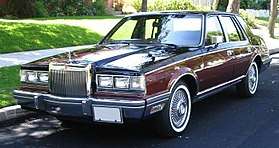 1982 Lincoln Continental (Givenchy Edition)
1982 Lincoln Continental (Givenchy Edition)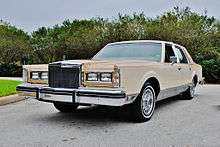 1984 Lincoln Town Car
1984 Lincoln Town Car.jpg) 1986-1987 Lincoln Continental
1986-1987 Lincoln Continental 1988-1991 Lincoln Continental
1988-1991 Lincoln Continental 1989 Lincoln Town Car Signature Series
1989 Lincoln Town Car Signature Series
Continental Mark VI and Mark VII
For 1980, the Continental Mark VI made its debut, replacing the Mark V. Originally slated to adopt the Ford Thunderbird chassis as part of downsizing, the Mark VI remained a full-size car, adopting the Ford Panther platform. Following the departure of Lee Iaccoca from Ford, the development of the Mark VI shifted from stand-alone model range to a four-door sedan and two-door coupe. Following its marketplace success, many design elements of the Mark V were carried onto the Mark VI, including its sharp-edged sheetmetal, hidden headlamps, opera windows, and fender louvers (now non-functional). The Mark VI coupe shared the same exact 114” Ford/Mercury wheelbase of the Panther chassis, with its own distinct roofline, while the four-door Mark VI shared its body with the Lincoln Continental/Town Car-Town Coupé, on a 3” longer wheelbase (at 117”).
The Mark VI continued the use of the Designer Series (for coupes); in 1982, the option packages began a revision, as the Cartier Edition was moved to the Town Car and the Givenchy Edition was moved to the Continental. In early-1982, the Givenchy Edition was re-introduced to the Mark VI lineup, (via a single-page insert to the showroom brochure) but would last only that year. In another tradition, in 1980, the Mark VI launched the Signature Series trim level. Initially intended as a direct replacement for the 1979 Collector's Series, the Signature Series designation would also be utilized by the Town Car beginning in 1981; in various forms, it would be used to its 2011 discontinuation...as well as the mid-size bustle-back Continental (for 1982 only). The heavily feature-equipped 1980-81 Mark VI Signature Series (padded vinyl trunk lid tire bulge, color-keyed bumper guards and rub strips, color-keyed trunk carpeting, color-keyed turbine wheels, tool kit, etc), received a de-contenting of many of these exclusive features for 1982-on, but now offered more colors and options. This ultimately became more of a parallel replacement of the former (1976-1981) “Luxury Group” offerings, which was absent from the option list for 1982-on.
For 1984, the Continental Mark VII replaced the Mark VI, again becoming a counterpart of the Ford Thunderbird. The most technically advanced vehicle sold by Lincoln-Mercury at the time, the Mark VII represented a major market shift, becoming the smallest version of the Mark series. From the 1979 Mark V to the 1984 Mark VII, Ford engineers shed 27 inches of length and over 1,200 pounds of curb weight. While slightly less performance-oriented than a grand-touring car, in its development, the Mark VII placed a far greater emphasis on handling capability than any previous Mark-series vehicle, with four-wheel disc brakes, anti-lock brakes, four-wheel air suspension; its 5.0L V8 was shared with the Ford Mustang.
In 1986, to eliminate the long-running nameplate confusion, the Continental Mark VII (marketed, sold and serviced by Lincoln) was renamed the Lincoln Mark VII, dropping the Continental nameplate. The Mark VII would be the final generation of the Mark series sold with a Designer Series name, with a Bill Blass Edition being sold through its production (a Gianni Versace edition was sold from 1984 to 1985), eventually becoming the standard model. As a sport-oriented model, Lincoln sold the Mark VII LSC (Luxury Sports Coupe) from 1984 to 1992.
.jpg) 1983 Continental Mark VI
1983 Continental Mark VI.jpg) rear view, 1983 Continental Mark VI
rear view, 1983 Continental Mark VI 1984-1985 Continental Mark VII LSC
1984-1985 Continental Mark VII LSC
1990s
While Lincoln exited the struggles of the Malaise era by 1990, the division found itself in a different struggle. While largely catching up to rival Cadillac in sales, the brand did so with only three model lines (in place of the seven of Cadillac and four of Mercedes-Benz). After following the traditional Lincoln model cycle, the Town Car underwent a full redesign. While mandated by both passive-restraint requirements and fuel-economy improvements, a redesign to the Town Car proved risky, as the model line itself accounted for over half of all Lincoln sales.[25]
To meet federal requirements, Lincoln marked the debut of several safety features within Ford Motor Company (and within the American luxury segment). Following the 1989 debut of dual airbags in the Lincoln Continental (1990 in the Town Car), antilock brakes (ABS) made their return on the Continental (1988) and on the Town Car (1992).
In line with the Lincoln Mark VII, the exterior of the Lincoln Town Car shed many of its sharp-edged lines to allow for a far sleeker body design; other elements remained, including a formal rear roofline, chrome trim, radiator-style grille, and C-pillar quarter windows. In line with the Lincoln Continental, the 1990 Town Car adopted dual airbags. Delayed to 1991, the Lincoln Town Car marked the debut of the 210hp 4.6L Ford Modular V8 engine, the first overhead-cam eight-cylinder used in an American car since the Duesenberg Model J. Built on a revision of the Panther platform, the 1990 Lincoln Town Car shared its underpinnings (but no exterior panels) with the 1992 Ford Crown Victoria (dropping the LTD prefix) and Mercury Grand Marquis
Following the introduction of the Mark VIII (see below), for 1995, the Lincoln Continental underwent a redesign, introducing a new version of the Ford Taurus chassis. Retaining the use of front-wheel drive, to better compete with Japanese-produced luxury sedans, the Continental was equipped with a 4.6L V8 engine (shared with the Mark VIII, tuned for front-wheel drive).
1998 marked a significant transition for the Lincoln model line. The Continental underwent a mid-cycle redesign, adding updated electronics and side airbags (the first time for a Lincoln). After a nine-year model model run, the Town Car underwent a major redesign of its exterior and interior, with the Panther chassis given a redesigned rear suspension. Partially influenced by the 1995 Continental and Lincoln Mark VIII, the exterior of the 1998 Town Car shifted to a far more rounded body, becoming the tallest Lincoln in 40 years. In contrast to the Mark VIII entering its final year of production, for 1998, Lincoln debuted the Lincoln Navigator full-size SUV. The first all-new Lincoln nameplate since the Lincoln Versailles, the Navigator shared its body with the Ford Expedition, competing against the Range Rover, Mercedes-Benz M-Class and Lexus LX450, the full-size Navigator offered additional cargo and towing capability unavailable in smaller luxury-oriented SUVs.
Following the success of the Navigator in the marketplace, 1998 marked the first year Lincoln outsold Cadillac (by over 4,500 vehicles).[26] As a response to the Navigator, Cadillac introduced the Cadillac Escalade, a rebadged GMC Yukon Denali (itself a Chevrolet Tahoe variant).
 1990-1992 Lincoln Town Car
1990-1992 Lincoln Town Car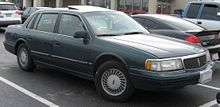 1992-1994 Lincoln Continental
1992-1994 Lincoln Continental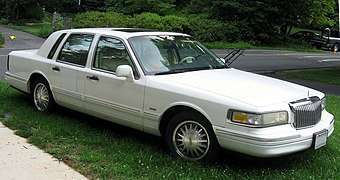 1995-1997 Lincoln Town Car
1995-1997 Lincoln Town Car 1995-1997 Lincoln Continental
1995-1997 Lincoln Continental 1998-2002 Lincoln Continental
1998-2002 Lincoln Continental 1998-2002 Lincoln Town Car Signature Series
1998-2002 Lincoln Town Car Signature Series 1998-2002 Lincoln Navigator
1998-2002 Lincoln Navigator
Lincoln Mark VIII
After a nine-year production run (matching the Mark IV and Mark V combined), the Lincoln Mark VII was replaced by the Lincoln Mark VIII, remaining a variant of the Ford Thunderbird/Mercury Cougar. This was the first generation of the Mark series originally branded as a Lincoln. Further emphasis was placed on handling, with the Mark VIII (and Thunderbird/Cougar) becoming the only American-produced four-seat cars of the time with rear-wheel drive and four-wheel independent suspension. While the Mark VIII adopted the coupe profile of its predecessor, in an effort to modernize its styling, much of the body was radically streamlined (relegating the spare-tire hump to vestigial status). In massive contrast from its 1970s predecessors, the Mark VIII was given a cockpit-style interior, with all controls oriented towards the driver. In various forms, elements of the Mark VIII would be featured in other Lincoln models (the 1995 Lincoln Continental and the 1995 Town Car interior), and other Ford Motor Company products (the interior of the Ford Windstar minivan).
While Designer Editions were discontinued, the LSC (Luxury Sports Coupe) made its return as the flagship Mark VIII model. During the 1990s, the Mark VIII competed in the mid-size luxury coupe segment, which was in overall decline. Though positively received by critics and buyers, the Mark VIII was withdrawn after the 1998 model year, outliving the Thunderbird and Cougar by a year. As of the 2019 model year, the 1998 Lincoln Mark VIII is currently the final version of Lincoln Mark series.
.jpg) 1993 Lincoln Mark VIII
1993 Lincoln Mark VIII.jpg) rear view, 1993 Lincoln Mark VIII
rear view, 1993 Lincoln Mark VIII 1998 Lincoln Mark VIII LSC
1998 Lincoln Mark VIII LSC rear view, 1998 Lincoln Mark VIII LSC
rear view, 1998 Lincoln Mark VIII LSC
2000s
As the division entered the 21st century, Lincoln began a period of major transition. In addition to ending production of the long-running Mark series, the Lincoln Navigator SUV had entered production, nearly unchallenged by European and Japanese manufacturers. As buyers of mid-size coupes in the luxury segments had shifted towards sports sedans, Lincoln developed an entry for the segment in the place of the Mark VIII. For 2000, Lincoln introduced the Lincoln LS mid-size sports sedan; coinciding with Premier Automotive Group (see below), the LS was developed alongside the Jaguar S-Type. Though the two vehicles shared a common chassis and related powertrain, no body panels were common between the two vehicles. The shortest Lincoln ever produced at the time, the LS was developed to compete with European and Japanese-produced counterparts, in line with the Cadillac Catera. While the Catera was imported from Germany (as a rebadged Opel Omega), the LS was produced alongside the Town Car and Continental in Wixom Assembly.
For 2002, Lincoln introduced the Lincoln Blackwood, the first pickup truck produced by the brand and the first Lincoln manufactured outside of Michigan since 1958 (along with the Versailles). Derived from the Ford F-150 SuperCrew, the Blackwood was fitted with the front bodywork of the Lincoln Navigator and a model-specific pickup bed (with imitation wood exterior trim). In line with its name, all examples were painted black. The Lincoln Blackwood met with poor reception, due to its limited cargo capability (its pickup bed was effectively a carpeted trunk) and lack of four-wheel drive, leading Lincoln to discontinue the model after a single year of production.
2003 marked a period of transition of the Lincoln model line, as both the Town Car and LS underwent mid-cycle updates (with the Town Car receiving a full chassis redesign), with Lincoln introducing the second generation of the Navigator. As a complement to the Navigator, Lincoln introduced the Lincoln Aviator mid-size SUV. Sharing the body of the Ford Explorer with the Mercury Mountaineer, the Aviator adopted many styling elements from the Navigator, with a nearly identical interior design. While priced higher than its Mercury Mountaineer counterpart to avoid model overlap, the Aviator struggled to sell, as it competed closely against the Navigator sold in the same showroom. After 52 years of production, the Continental was discontinued for 2003.
For 2005, Lincoln introduced a second pickup truck model line, the Lincoln Mark LT. Again based on the Ford F-150 SuperCrew, the design of the Mark LT was partially derived from the poor reception to the Lincoln Blackwood. While still fitted with Lincoln Navigator bodywork and interior trim, the Mark LT was fitted with a standard pickup bed; all wheel drive was available as an option. Following lower than expected sales, the Mark LT was withdrawn from the United States (in favor of Ford adding additional content to the Ford F-Series) in 2008; in Mexico (where the Mark LT was the highest-selling vehicle of the brand) Lincoln continued sales of the Mark LT through 2014.[27]
During 2006, The Way Forward restructuring plan (see below) began to take effect on Ford Motor Company, with the Lincoln LS ending production. To replace the LS, Lincoln introduced the Lincoln Zephyr for 2006. In what would be the smallest Lincoln sedan ever, the Zephyr was derived from the Ford Fusion mid-size sedan. In an effort to distinguish itself from its Ford and Mercury counterparts, the Lincoln Zephyr adapted styling elements from Lincoln vehicles of the past, including a wide rectangular grille (1960s and 1970s Continentals), wraparound headlamps (late 1960s Continentals), and a twin-pod dashboard (early 1960s Continental).
In 2007, as another part of The Way Forward, Lincoln began a rebranding of its model line. As Ford considered the Lincoln Mark series to have high nameplate recognition, Lincoln began to introduce similar "MK" branding across the model lineup. For 2007, the Lincoln Zephyr was rebranded as the Lincoln MKZ ("em-kay-zee"), with the 2007 Lincoln MKX ("em-kay-ex") crossover SUV introduced. Originally slated to become the second-generation Lincoln Aviator, the MKX was the Lincoln counterpart of the Ford Edge. Alongside the Lincoln Town Car, the Lincoln Navigator was not included with the MK rebranding; for 2007, it was redesigned alongside the Ford Expedition, marking the debut of the extended-length Navigator L. For the last time, a Designer Series Lincoln was produced, as Lincoln discontinued the trim on the Town Car after 2007. Produced only as a concept car, the 2007 Lincoln MKR marked the debut of the Ford EcoBoost V6.
For 2009, Lincoln introduced its first all-new full-size sedan since 1980, the Lincoln MKS. Intended to be phased in as the replacement for the Lincoln Town Car, the MKS was the Lincoln counterpart of the Ford Taurus. Built on a Volvo-derived chassis, the MKS was the first full-size Lincoln with front-wheel drive (or optional all-wheel drive); shared with the Ford Taurus SHO, a 3.5L twin-turbocharged V6 was an option. Derived from the 2007 MKR concept, the MKS marked the production debut of the "split-wing" grille, a design element similar to the 1930s Lincoln Zephyr. A year later, the division introduced the Lincoln MKT crossover SUV, a counterpart of the Ford Flex. Sharing its chassis with the MKS, the MKT was sized between the MKX and standard-wheelbase Navigator.
 2002 Lincoln Blackwood
2002 Lincoln Blackwood- 2003-2007 Lincoln Town Car Signature Series
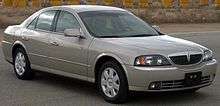 2004 Lincoln LS
2004 Lincoln LS 2006 Lincoln Aviator
2006 Lincoln Aviator 2007 Lincoln Navigator L
2007 Lincoln Navigator L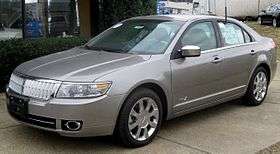 2009 Lincoln MKZ
2009 Lincoln MKZ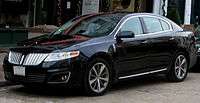 2009 Lincoln MKS
2009 Lincoln MKS
Premier Automotive Group & The Way Forward
As Lincoln entered the 21st century, the brand underwent a major transition within the structure of Ford Motor Company. As Ford expanded its global automotive holdings during the 1980s and 1990s, it acquired Jaguar, Aston Martin, Land Rover, and Volvo Cars. To collectively manage its global luxury-vehicle holdings, in 1999, Ford organized Premier Automotive Group (PAG). The same year, the management of Lincoln-Mercury was shifted to the American headquarters of PAG, largely in an effort to engineer and market more competitive vehicles for the brand.[28]
The integration of Lincoln into PAG would lead to several product changes within the division. Following the 2000 debut of the LS sports sedan, the Lincoln Continental was withdrawn in 2002. To avoid the model overlap that plagued the division two decades before, Lincoln chose to focus production on the Lincoln Town Car, one of the highest-profit vehicles of Ford Motor Company.
During 2002, as part of a change of management, Lincoln-Mercury was removed from PAG and relocated within Ford Motor Company headquarters.
In 2005, Ford developed The Way Forward restructuring plan in an effort to return to profitability. Among the seven vehicle assembly facilities slated for closure, Wixom Assembly (home to all Lincoln assembly since 1957, with the exception of the Versailles, Navigator, Blackwood, and Mark LT) was placed third, with an announced June 2007 closure. After a shortened 2006 model year, the Lincoln LS ended production. Initially slated for discontinuation after 2007, production of the Lincoln Town Car was shifted to St. Thomas Assembly in Ontario, consolidated with the Ford Crown Victoria and Mercury Grand Marquis. In 2011, all three vehicles ended production, coinciding with the closure of that facility.
2010s
For the Lincoln division, the beginning of the 2010s introduced a number of structural changes. While Lincoln and Mercury were spared by The Way Forward, in 2010, Ford announced the closure of Mercury at the end of the year, with the final Mercury vehicle produced on January 4, 2011. After 30 years of production as a distinct model line (and 41 years as a Lincoln nameplate), the Lincoln Town Car ended its production run in 2011, coinciding with the closure of St. Thomas Assembly in Ontario. In contrast to the V8-engined Lincoln Town Car, for 2011, Lincoln introduced the MKZ Hybrid, a counterpart of the Ford Fusion Hybrid. The first Lincoln hybrid vehicle, the MKZ Hybrid was the first Lincoln equipped with a four-cylinder engine. Following the discontinuation of the Town Car sedan, Lincoln continued use of the Town Car nameplate, adding it to limousine and livery variants of the Lincoln MKT. Along with chassis modifications for heavy-duty use, the MKT Town Car features modified rear seating, with the third-row seat removed to create additional luggage space and second-row seat legroom.
To reflect the end of the Lincoln-Mercury division pairing (from 1945 to 2010), in December 2012, the formal name of Lincoln was changed to The Lincoln Motor Company (its name prior to 1940).[29] To help differentiate Lincoln vehicles from Ford counterparts, Ford established separate design, product development, and sales teams for Lincoln.[30] In a marketing shift, Lincoln began to target "progressive luxury customers". luxury buyers seeking a vehicle solely for their own interests and avoiding ostentation altogether.[31][29]
As part of the 2012 rebranding, for 2013, the Lincoln model line underwent several design revisions, headed by the release of the second-generation MKZ. Retaining commonality with the Ford Fusion (a rebadged Ford Mondeo), the MKZ adapted a distinct exterior from its Fusion/Mondeo counterparts (nearly unchanged from a Lincoln concept car released in 2012).[31] The MKS and MKT underwent exterior and interior revisions, adopting the "bow-wing" grille design of the MKZ. Also during this time, Lincoln introduced new trim level nomenclatures Premiere, Select and Reserve on the MKZ. Use of these trim names would eventually be expanded to other Lincoln models.
For 2015, Lincoln introduced two new SUVs, with the all-new Lincoln MKC compact crossover SUV (derived from the Ford Kuga/Ford Escape) becoming the first Lincoln produced solely with four-cylinder engines. The Lincoln Navigator underwent an extensive revision, largely to preview buyers of its 2018 redesign. Along with extensive exterior and interior updates, the Navigator adopted the 3.5L twin-turbocharged V6 of the Ford F-150 as its standard engine, becoming the first version of the Navigator offered without a V8 engine.
Following the positive reception to a 2015 concept car of the same name, Lincoln revived the Lincoln Continental nameplate for the 2017 model year (after a 15-year hiatus). Slotted as a replacement for the Lincoln MKS, the Continental was adapted from a version of the Ford Taurus designed for China. While slightly shorter than the MKS, the Continental is the longest-wheelbase Lincoln since the Town Car. The revived model line introduced a new design language for Lincoln; shifting away from the split-wing grille, the Continental introduced a recessed rectangular grille. The revived Continental marked the debut of the Lincoln "Black Label" program for all Lincoln vehicles. As a flagship trim line, Black Label vehicles feature specially coordinated exterior and interior design themes (similar to the Designer Editions of the Mark series), along with highly personalized customer service.
For 2018, after an eleven-year production run of its predecessor, Lincoln released the fourth generation of the Navigator. Integrating the recessed rectangular grille of the Continental into its exterior, the Navigator is distinguished from the Ford Expedition largely from its taillamps and its blacked-out roof pillars (sharing the "floating roof" design of the Ford Flex and Ford Explorer). With the exception of the Ford GT supercars, at a base price of $95,000, the Lincoln Navigator Black Label is the most expensive vehicle ever sold by Ford Motor Company. The Lincoln MKZ underwent a mid-cycle redesign, adopting the grille design and twin-turbocharged V6 engine of the Lincoln Continental.
Coinciding with the revival of the Lincoln Continental replacing the Lincoln MKS as its flagship sedan, Lincoln has begun to phase out its "MK" branding as model cycles of its vehicles are completed.[32] For 2019, the Lincoln MKX underwent a mid-cycle redesign, becoming the Lincoln Nautilus.
 2011 Lincoln MKX
2011 Lincoln MKX- 2013 Lincoln MKT Town Car
 2015 Lincoln MKC
2015 Lincoln MKC 2016 Lincoln MKX
2016 Lincoln MKX 2017 Lincoln MKZ
2017 Lincoln MKZ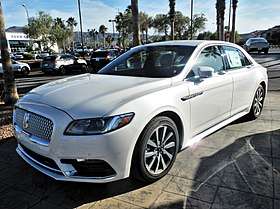 2018 Lincoln Continental
2018 Lincoln Continental 2018 Lincoln Navigator L Black Label
2018 Lincoln Navigator L Black Label
Worldwide distribution
Asia
In the 1990s and 2000s, Hongqi produced a license-built version of the Lincoln Town Car, based on knock-down kits imported from the United States.[33] In an effort to develop a successor to the Hongqi CA770, the Town Car kits were given an exterior redesign with different front fenders, headlamps, taillamps, and grille. Along with a standard-wheelbase sedan, three lengths of limousines were produced, along with the Hongqi CA7400 prototype.[33]
In 2014, Ford Motor Company brought the Lincoln brand to China, launching the brand with the mid-size MKZ sedan and MKC small SUV.[34] By the end of 2016, Lincoln intended to establish a network of 60 dealerships in 50 cities, selling the MKZ, Continental, MKC, MKX, and Navigator.[35] 2016 sales increased 180% over the previous year, with Lincoln planning to produce vehicles in China by 2019.[36] To attract Chinese consumers, Lincoln introduced "The Lincoln Way", a car purchase and ownership model which provides highly personalized services to customers.[37]
Europe
In Europe, Ford Motor Company does not currently market the Lincoln brand. To compete against luxury-brand automobiles, Ford offers the Fiesta, Mondeo, Kuga, Edge, and S-Max under the Vignale brand name.[38]
Sales
Lincoln achieved its two best U.S. sales years to date in 1989 (200,315) and 1990 (231,660), thanks largely to the popularity of the redesigned Continental, introduced in December 1987, and of the redesigned Town Car introduced in October 1989.
Branding history
Since 1958, Lincoln has used a framed four-pointed star as its brand logo. Introduced on the Continental Mark II in 1956, the four-point star has undergone various modifications in appearance, but has remained nearly unchanged since 1980.
In 1927, Lincoln adopted a greyhound as a hood ornament, used into the 1930s.[39] As a replacement for the greyhound, Lincoln adopted a knight's helmet hood ornament, used before World War II. On the front fascia, Lincoln adopted a coat of arms with a red cross. Following the war, Lincolns adopted a rocket-style hood ornament until the adoption of the four-point star from the Mark II.
Current model line
| Model | Category | Years |
|---|---|---|
| Lincoln Navigator | Full-size SUV | 1998–present |
| Lincoln MKZ | Mid-size sedan | 2007–present |
| Lincoln MKT/MKT Town Car | Mid-size crossover SUV | 2010–present |
| Lincoln MKC | Compact crossover | 2015–present |
| Lincoln Continental | Full-size sedan | 2017–present |
| Lincoln Nautilus | Mid-size SUV | 2019–present |
Motorsport
Although a luxury division, Lincoln has not been absent from motorsports. Like all American brands of the 1950s, Lincoln participated in the Grand National Stock Car series. They would continue into the 1980s until the Winston Cup Series dwindled down into a Chevrolet-Pontiac-Ford affair in the 1990s.
The Continental Mark VII was raced in the Trans-Am Series in 1984 and 1985 without much success, with the best result being a ninth-place finish (at the 1984 Watkins Glen Trans-Am race[40]).
Lincoln has also powered Le Mans Prototypes, acting as a substitute for Ford, in the American Le Mans Series.
Presidential cars
During the 20th century, Lincoln produced several official state limousines for Presidents of the United States, from Franklin D. Roosevelt to George H. W. Bush. Along with producing the first purpose-built presidential limousine, Lincoln produced two of the first armored vehicles for presidential use.
A 1939 Lincoln Model K V12 convertible (with a Brunn body) was acquired by the government for the use of Franklin D. Roosevelt. As a result of its convertible top (to allow the president to appear in crowds without exiting the vehicle), the Lincoln adapted the name "Sunshine Special". In 1942, as a response to the beginning of World War II, the Sunshine Special adapted armor plating and bullet-proof glass; the retractable roof remained in use. Following the result of the security upgrades, the Sunshine Special expanded to 9,300 pounds. After traveling across the United States for the Roosevelt and Truman administrations, the Sunshine Special was retired in 1948. Today, the Sunshine Special is on display at the Henry Ford Museum in Dearborn, Michigan.
As a replacement for the Sunshine Special, in 1950, the White House leased 10 1950 Lincoln Cosmopolitans (9 sedans and one convertible), bodied by Henney Motor Company with security upgrades from Hess & Eisenhardt. For 1954, President Eisenhower ordered a removable Plexiglas roof fitted to the 20-foot long Cosmopolitan convertible, with the vehicle adapting the "Bubble Top" nickname. Along with the Truman and Eisenhower administrations, Lincoln Cosmopolitans would see use by Presidents John F. Kennedy and Lyndon B. Johnson (once), with the "Bubble Top" retired in 1965.
In 1961, President Kennedy began use of a modified 1961 Lincoln Continental convertible, bodied by Hess & Eisenhardt of Cincinnati, Ohio. Code-named SS-100-X, the Lincoln was an open car, designed with a set of interchangeable tops, including a black formal-profile top, plexiglass roof sections and a stainless-steel targa top for the driver's compartment. In presidential parades and motorcades, the limousine was often used as an open car (to avoid stress on the cooling system). In the open configuration, John F. Kennedy was assassinated in November 1963. Following the Kennedy assassination, SS-100X was initially investigated for evidence; in early 1964, the vehicle was released to Hess & Eisenhardt, effectively becoming remanufactured. Distinguished by a shift from navy blue to black paint and the permanent fitment of a roof, SS-100X underwent extensive security modifications, adding armor plating and bulletproof glass. Retired from front-line service in 1967, the 1961 limousine remained in service until 1977, used by Presidents Johnson, Richard M. Nixon, Gerald R. Ford, and Jimmy Carter. SS-100X is on display at the Henry Ford Museum in Dearborn, Michigan, along with the Sunshine Special.
During the 1960s, alongside SS-100X, the Johnson administration used several Lincolns: including three 1965 Lincoln Continental Executive limousines (two used by the President; one was used by Secretary of Defense Robert McNamara) and a 1968 Lincoln stretch limousine, the latter is on display at the Lyndon Baines Johnson Library and Museum in Austin, Texas.
For the Richard Nixon administration, the White House commissioned a state limousine based upon a 1969 Lincoln Continental, bodied by Lehman-Peterson of Chicago, Illinois. While again adopting the armor plating and bulletproof glass and other security features of SS-100X, to allow the President to stand upright and greet constituents from the motorcade, a sunroof was added to the vehicle above the rear passenger compartment. Used by President Nixon until 1974, the car is located at the Nixon Library in Yorba Linda, California.
Developed for the second term of the Nixon administration, in 1974, the Gerald Ford administration replaced the 1969 Continental with an armored 1972 Lincoln Continental limousine. As a result of armor plating and security upgrades, the 1972 Continental was stretched to 22 feet in length, weighing nearly 13,000 pounds. Used by Gerald Ford, Jimmy Carter, and Ronald Reagan, the 1972 Continental has notoriety similar to the SS-100X, with its presence at two presidential assassination attempts. In 1975, the limousine rushed Gerald Ford away during the assassination attempt against him from Sarah Jane Moore. In 1981, Ronald Reagan was wounded in John Hinckley, Jr.'s assassination attempt. While not directly hit by a bullet from Hinckley, Reagan was wounded by a bullet that had struck the armor plating on the side of the car, richocheting off of the vehicle. Today, the car is on display at the Henry Ford Museum alongside the Sunshine Special and SS-100-X.
The last current Lincoln used as a Presidential state car is a 1989 Lincoln Town Car, replacing a 1983 Cadillac Fleetwood Brougham. Commissioned for George H. W. Bush, the roofline was raised several inches to accommodate for the thickness of bulletproof glass. To better handle the weight of armor plating and security upgrades, the Town Car adopted the powertrain of a Ford F-250 pickup truck, powered by a 7.5L V8 and a heavy-duty E4OD 4-speed automatic transmission. Today, the car is on display at the George Bush Presidential Library in College Station, Texas.
Following the 1989 Lincoln Town Car of George H.W. Bush, subsequent state limousines used by Bill Clinton and George W. Bush and the current one used by Barack Obama and incumbent President Donald Trump has been Cadillac branded vehicles.
.jpg) "Sunshine Special", 1939 Lincoln Model K convertible/Brunn body
"Sunshine Special", 1939 Lincoln Model K convertible/Brunn body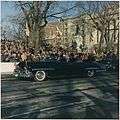 1950 Lincoln Cosmopolitan convertible (John F. Kennedy inaugural parade)
1950 Lincoln Cosmopolitan convertible (John F. Kennedy inaugural parade).jpg) SS-100X (1961 Lincoln Continental convertible) parked in front of White House, June 1963
SS-100X (1961 Lincoln Continental convertible) parked in front of White House, June 1963.jpg) SS-100X, 1961 Lincoln Continental convertible, shown after permanent top conversion
SS-100X, 1961 Lincoln Continental convertible, shown after permanent top conversion- 1969 Lincoln Continental limousine
.jpg) 1972 Lincoln Continental limousine
1972 Lincoln Continental limousine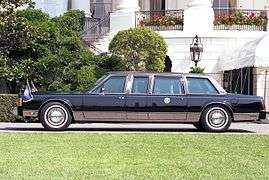 1989 Lincoln Town Car limousine
1989 Lincoln Town Car limousine
See also
References
- 1 2 Lincoln Motor Company Briefing Book (PDF). New York: Ford Motor Company. December 3, 2012. Archived from the original (PDF) on December 4, 2012. Retrieved December 3, 2012.
1917 August: After departing a management position at the Cadillac Division of General Motors, Henry Leland and his son Wilfred Leland form the Lincoln Motor Company, which produces aircraft engines to fill World War I government contracts.
- ↑ "Our Brands: Lincoln Vehicles". Ford Motor Corporation. 2012. Archived from the original on April 28, 2014. Retrieved April 29, 2014.
- ↑ "Joy Falotico". Ford Media Center. Retrieved March 29, 2018.
- ↑ Davis, Michael W. R. (2002). Ford Dynasty: A Photographic History. Arcadia Publishing. pp. 54–55. ISBN 9780738520391. Retrieved 28 March 2018.
- ↑ Banham, Russ (2002). The Ford Century: Ford Motor Company and the Innovations that Shaped the World. Artisan Books. p. 95. ISBN 9781579652012. Retrieved 28 March 2018.
- ↑ Buss, Dale (December 3, 2012). "Ford Introduces the "Lincoln Motor Company" in New Branding Campaign". brandchannel. Retrieved March 29, 2018.
- ↑ "Lincoln China Sets Sales Record; Lincoln Global Sales Deliver Best Performance Since 2000". media.lincoln.com. Retrieved 2018-05-18.
- ↑ Lincoln Motor Company Briefing Book (PDF). New York: Ford Motor Company. December 3, 2012. Archived from the original (PDF) on December 4, 2012. Retrieved December 3, 2012.
1917 August: After departing a management position at the Cadillac Division of General Motors, Henry Leland and his son Wilfred Leland form the Lincoln Motor Company, which produces aircraft engines to fill World War I government contracts.
- ↑ O'Callaghan, Timothy J. (2002). The Aviation Legacy of Henry & Edsel Ford. Detroit: Wayne State University Press. ISBN 1-928623-01-8.
- ↑ "1917 Lincoln Model L Pictures, History, Value, Research, News - conceptcarz.com". conceptcarz.com. Retrieved 2018-05-18.
- ↑ "Ford buys Lincoln - Feb 04, 1922". History.com. 2009. Retrieved 28 March 2018.
- ↑ Poe, Nathan. "Lincoln Motor Plant". U.S. National Park Service. Retrieved 28 March 2018.
- ↑ Bentley, John (1952). The Old Car Book. 208.
- ↑ Dammann, George H.; Wagner, James K. (1987). The Cars of Lincoln-Mercury. Crestline Publishing. ISBN 978-0912612263.
- ↑ Burgess-White, David (1974). Ward, Ian, ed. The World of Automobiles: An Illustrated Encyclopedia of the Motor Car. vol. 10. Orbis Publishing. ASIN B008G7ICEK.
- 1 2 Dammann, George H.; Wagner, James K. (1987). The Cars of Lincoln-Mercury. Crestline Publishing. ISBN 978-0912612263.
- ↑ Federal Reserve Bank of Minneapolis Community Development Project. "Consumer Price Index (estimate) 1800–". Federal Reserve Bank of Minneapolis. Retrieved January 2, 2018.
- 1 2 Dammann, George H.; Wagner, James K. (1987). The Cars of Lincoln-Mercury. Crestline Publishing. ISBN 978-0912612263.
- 1 2 "1961 Lincoln Continental". HowStuffWorks. 2007-10-11. Retrieved 2018-05-19.
- ↑ "1961 Lincoln Continental". HowStuffWorks. 2007-10-11. Retrieved 2018-05-20.
- ↑ "1966-1969 Lincoln Continental". HowStuffWorks. 2007-09-04. Retrieved 2018-05-20.
- ↑ "1967 Lincoln Continental 4-Door Convertible full range specs". www.automobile-catalog.com. Retrieved 2018-05-20.
- ↑ "How Lincoln Cars Work". HowStuffWorks. 2007-06-08. Retrieved 2018-05-20.
- ↑ Loidl, Gerald. "The History of my Mark III". www.eldorado-seville.com. Retrieved 2018-05-20.
- ↑ "How Lincoln Cars Work". HowStuffWorks. 2007-06-08. Retrieved 2018-05-22.
- ↑ O'DELL, JOHN (1999-05-06). "Cadillac Apologizes to Lincoln for Inflating Sales Numbers". Los Angeles Times. ISSN 0458-3035. Retrieved 2018-05-22.
- ↑ "El poder es producto de la superacion". Archived from the original on January 6, 2013. Retrieved January 15, 2013.
- ↑ "How Lincoln Cars Work". HowStuffWorks. 2007-06-08. Retrieved 2018-05-22.
- 1 2 "Lincoln Forges Dynamic New Path with the Introduction of 'The Lincoln Motor Company' and All-New MKZ Luxury Vehicle" (Press release). New York: Ford Motor Company. December 3, 2012. Archived from the original on December 4, 2012. Retrieved December 3, 2012.
The company, introduced as The Lincoln Motor Company, unveiled its all-new MKZ midsize luxury sedan and a strategic plan to reinvent the premium automotive marketplace
- ↑ Dyer, Ezra (December 21, 2012). "Lincoln Strategy: We'll Try Anything". The New York Times. Retrieved March 29, 2018.
- 1 2 Dapena-Valdes, Peter (December 3, 2012). "Ford Restarts Lincoln Motor Co". CNN. Archived from the original on December 4, 2012. Retrieved December 3, 2012.
As it attempts to revive a once-great luxury brand, Ford's is renaming its Lincoln division as the Lincoln Motor Co., the automaker said Monday.
- ↑ "2019 Lincoln Nautilus First Look: MKX Replacement Gets New Name". Motor Trend. 2017-11-28.
- 1 2 "Tycho's Illustrated History Of Chinese Cars: Red Flag's Lincoln Years - The Truth About Cars". The Truth About Cars. 2012-01-05. Retrieved 2018-05-23.
- ↑ "Lincoln Launches in China; Unique Offering for Today's Chinese Luxury Auto Customers" (Press release). Lincoln Motor Company. Retrieved June 30, 2015.
- ↑ "Lincoln Unveils Three All-New Vehicles at Auto Shanghai 2015" (Press release). Lincoln Motor Company. Retrieved June 30, 2015.
- ↑ "Ford's Lincoln plans to produce luxury SUV in China by late 2019". Reuters. March 13, 2017. Retrieved April 30, 2018.
- ↑ "Lincoln Opens First Stores in China and Unveils 'The Lincoln Way'" (Press release). Lincoln Motor Company. November 6, 2014. Retrieved April 30, 2018.
- ↑ "Ford Vignale - Ford GB". ford.co.uk. Retrieved November 20, 2016.
- ↑ "1927 Lincoln Model L Pictures, History, Value, Research, News". conceptcarz.com. Retrieved 2018-05-23.
- ↑ "Lincoln Mark VII-Theus". RacingSportsCars.
External links
| Wikimedia Commons has media related to Lincoln vehicles. |
- Official website
- Lincoln at Curlie (based on DMOZ)
- Website of Lincoln Presidential Limousines
Lincoln passenger vehicle timeline, 1922–1979 — next » | |||||||||||||||||||||||||||||||||||||||||||||||||||||||||||
|---|---|---|---|---|---|---|---|---|---|---|---|---|---|---|---|---|---|---|---|---|---|---|---|---|---|---|---|---|---|---|---|---|---|---|---|---|---|---|---|---|---|---|---|---|---|---|---|---|---|---|---|---|---|---|---|---|---|---|---|
| Type | 1920s | 1930s | 1940s | 1950s | 1960s | 1970s | |||||||||||||||||||||||||||||||||||||||||||||||||||||
| 2 | 3 | 4 | 5 | 6 | 7 | 8 | 9 | 0 | 1 | 2 | 3 | 4 | 5 | 6 | 7 | 8 | 9 | 0 | 1 | 2 | 3 | 4 | 5 | 6 | 7 | 8 | 9 | 0 | 1 | 2 | 3 | 4 | 5 | 6 | 7 | 8 | 9 | 0 | 1 | 2 | 3 | 4 | 5 | 6 | 7 | 8 | 9 | 0 | 1 | 2 | 3 | 4 | 5 | 6 | 7 | 8 | 9 | ||
| Mid-size | WWII | Versailles | |||||||||||||||||||||||||||||||||||||||||||||||||||||||||
| Entry-level | Lincoln-Zephyr | Zephyr | Lincoln (H) | Lincoln (EL) | Cosmopolitan | Custom | Capri | Capri | Lincoln | Continental | Continental | ||||||||||||||||||||||||||||||||||||||||||||||||
| Full-size | Cosmopolitan | Capri | Premiere | Premiere | Continental Town Car | ||||||||||||||||||||||||||||||||||||||||||||||||||||||
| L-Series | |||||||||||||||||||||||||||||||||||||||||||||||||||||||||||
| Limousine | L-Series | K-Series | Custom | Town Car/Limousine | |||||||||||||||||||||||||||||||||||||||||||||||||||||||
| Halo car | K-Series | Continental Mark III–V | |||||||||||||||||||||||||||||||||||||||||||||||||||||||||
| Personal luxury car | Continental | Continental | Continental Mark II | Mark III | Mark IV | Mark V | |||||||||||||||||||||||||||||||||||||||||||||||||||||
| Type | 1980s | 1990s | 2000s | 2010s | ||||||||||||||||||||||||||||||||||||
| 0 | 1 | 2 | 3 | 4 | 5 | 6 | 7 | 8 | 9 | 0 | 1 | 2 | 3 | 4 | 5 | 6 | 7 | 8 | 9 | 0 | 1 | 2 | 3 | 4 | 5 | 6 | 7 | 8 | 9 | 0 | 1 | 2 | 3 | 4 | 5 | 6 | 7 | 8 | 9 | |
| Mid-size | Versailles | Continental | Continental | Continental | Zephyr / MKZ | MKZ | ||||||||||||||||||||||||||||||||||
| LS | ||||||||||||||||||||||||||||||||||||||||
| Full-size | MKS | Continental | ||||||||||||||||||||||||||||||||||||||
| Continental | Town Car | Town Car | Town Car | |||||||||||||||||||||||||||||||||||||
| Personal luxury car | Continental Mark VI | Continental/Lincoln Mark VII | Lincoln Mark VIII | |||||||||||||||||||||||||||||||||||||
| Mid-size SUV | Aviator | |||||||||||||||||||||||||||||||||||||||
| Full-size SUV | Navigator | Navigator | Navigator | Navigator | ||||||||||||||||||||||||||||||||||||
| Compact CUV | MKC | |||||||||||||||||||||||||||||||||||||||
| Mid-size CUV | MKX | MKX / Nautilus | ||||||||||||||||||||||||||||||||||||||
| Full-size CUV | MKT | |||||||||||||||||||||||||||||||||||||||
| Pickup truck | Blackwood | Mark LT | Mark LT (Mexico) | |||||||||||||||||||||||||||||||||||||